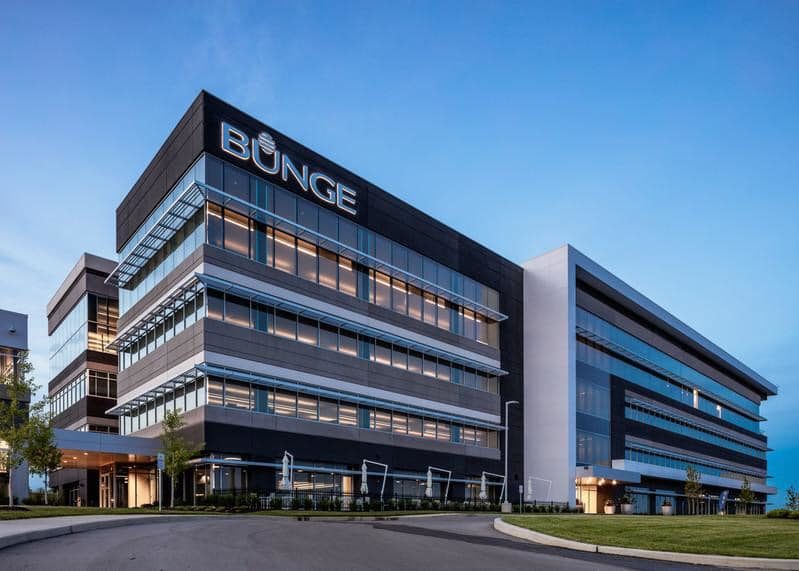ST. LOUIS, MISSOURI, US — The power of its global network and operating model came to the fore at Bunge Ltd. during the third quarter as the St. Louis-based company posted strong earnings and sales in the period. Moving forward, the company remains confident in its ability to react and capture market opportunities.
In the third quarter ended Sept. 30, Bunge posted income of $653 million, equal to $4.28 per share on the common stock, up 149% from $262 million, or $1.84 per share, in the third quarter a year ago.
Sales were $14.12 billion, up 39% from $10.16 billion a year ago.
Following the release of the strong results and in light of favorable market trends, Bunge raised its adjusted earnings-per-share outlook to at least $11.50 per share, up from $8.50 previously. The news helped buoy Bunge’s share price, which climbed as high as $91.15 on Oct. 27, up 4.4% from the close of $87.25 on Oct. 26.
“In the second half of 2021, we’ve seen a shift in the challenges created by the COVID operating environment,” Gregory A. Heckman, chief executive officer, said during an Oct. 27 conference call with analysts. “We’ve moved away from having to adjust to the fluctuations that came from lockdowns, like the change in demand from foodservice to food processors. Instead, we’re adapting to an environment that is driven by an uneven global recovery. This dynamic demand is driving increases in commodity and energy prices and creating many supply chain challenges.”
In addition to solid operational execution, Heckman said Bunge’s positioning and approach to risk management has allowed it to capture opportunities quickly.
“This was especially true as crush margins improved over the late summer, when oilseed prices dropped and oil values expanded due to tightening supply,” he said. “The strength of our global platform and footprint continue to provide benefits. In the face of broad logistical disruptions, our integrated value chains and owned ports have helped us to continue supporting customers at both ends of the supply chain.”
Bunge’s largest division, Agribusiness, had adjusted segment EBIT in the third quarter of 2021 of $533 million, up nearly 10% from $485 million in 2020. Agribusiness volumes were 30.49 million tonnes, down 16% from 36.32 million tonnes in the third quarter a year ago. Sales were $9.87 billion, up 35% from $7.29 billion in the third quarter of 2020.
“In processing, higher results in North America, European soft seeds and our Asian and European destination soy value chains, all benefited from improved margins,” said John W. Neppl, executive vice president and chief financial officer. “These were partially offset by lower results in South America, where margins were down from a strong prior year. In merchandising, improved performance was primarily driven by higher results in ocean freight due to strong execution and our global vegetable oil value chain, which benefited from increased margins.”
Adjusted EBIT of the Refined and Specialty Oils division was $142 million, up 112% from $67 million in the third quarter of 2020. Sales were $3.65 billion, up 50% from $2.43 billion.
“The strong performance in the quarter was primarily driven by higher margins and volumes in North American refining, which continued to benefit from the recovery in foodservice and increased demand from the renewable diesel sector,” Neppl said. “Higher margins in Europe, largely driven by favorable product mix, also contributed to the improved performance. Results in South America and Asia were slightly higher than last year.”
Adjusted EBIT of the Milling Products division totaled $23 million, down 18% from $28 million in the third quarter of 2020. Net sales increased to $530 million from $388 million.
“Lower results in the quarter were driven by Brazil, where higher volume and lower unit costs were more than offset by lower margins,” Neppl said. “Results in North America were comparable with last year.”
Neppl said pace of spending on capital expenditures was below expectations, reflecting supply chain-related delays. He noted that Bunge does not see that scenario improving over the remaining months of 2021, and as a result the company has reduced its 2021 CapEx forecast by about $100 million.
“We’ll be rolling over these projects into next year,” he said. “In addition, we have a nice pipeline of growth and productivity investments that are under consideration, which will likely lead to a higher-than-baseline spend for the next couple of years.”




